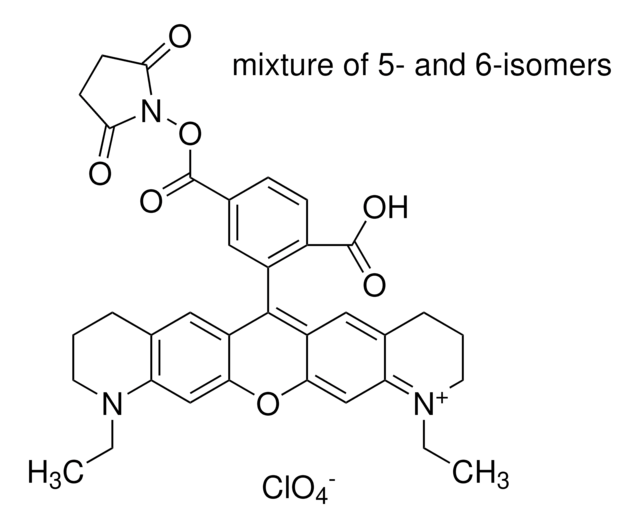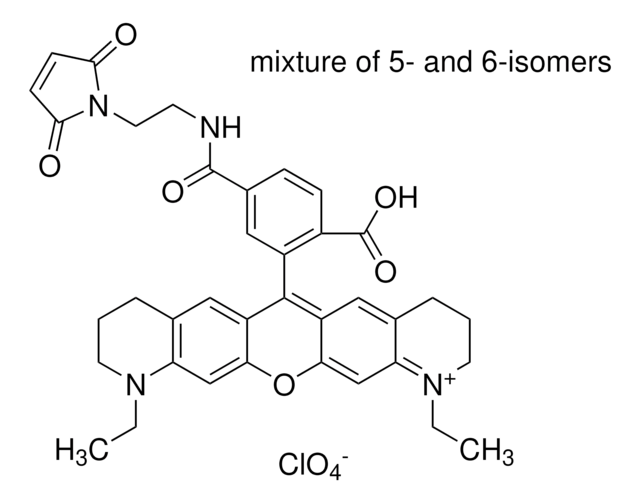All Photos(1)
About This Item
Empirical Formula (Hill Notation):
C31H31ClN2O9
Molecular Weight:
611.04
MDL number:
UNSPSC Code:
12352108
NACRES:
NA.32
Recommended Products
product line
BioReagent
Quality Level
assay
≥90.0% (HPLC)
form
powder
manufacturer/tradename
ATTO-TEC GmbH
λ
in ethanol (with 0.1% trifluoroacetic acid)
UV absorption
λ: 562.0-568.0 nm Amax
suitability
suitable for fluorescence
storage temp.
−20°C
Looking for similar products? Visit Product Comparison Guide
Application
Atto fluorescent labels are designed for high sensitivity applications, including single-molecule detection. Atto labels have rigid structures that do not show any cis-trans isomerization. Thus these labels display exceptional intensity with minimal spectral shift on conjugation.
Atto 565 shows a molar extinction of 120.000 and QY of 92% in water (97% in ethanol). Decay time is 3.4 ns.
Atto 565 shows a molar extinction of 120.000 and QY of 92% in water (97% in ethanol). Decay time is 3.4 ns.
Specific and stable fluorescence labeling of histidine-tagged proteins
Legal Information
This product is for Research use only. In case of intended commercialization, please contact the IP-holder (ATTO-TEC GmbH, Germany) for licensing.
Storage Class
11 - Combustible Solids
wgk_germany
WGK 3
flash_point_f
Not applicable
flash_point_c
Not applicable
ppe
Eyeshields, Gloves, type N95 (US)
Choose from one of the most recent versions:
Already Own This Product?
Find documentation for the products that you have recently purchased in the Document Library.
Customers Also Viewed
Suman Lata et al.
Journal of the American Chemical Society, 128(7), 2365-2372 (2006-02-16)
Labeling of proteins with fluorescent dyes offers powerful means for monitoring protein interactions in vitro and in live cells. Only a few techniques for noncovalent fluorescence labeling with well-defined localization of the attached dye are currently available. Here, we present
Łukasz Krzemiński et al.
Journal of the American Chemical Society, 133(38), 15085-15093 (2011-08-26)
A combined fluorescence and electrochemical method is described that is used to simultaneously monitor the type-1 copper oxidation state and the nitrite turnover rate of a nitrite reductase (NiR) from Alcaligenes faecalis S-6. The catalytic activity of NiR is measured
Takao Nakata et al.
The Journal of cell biology, 194(2), 245-255 (2011-07-20)
Polarized transport in neurons is fundamental for the formation of neuronal circuitry. A motor domain-containing truncated KIF5 (a kinesin-1) recognizes axonal microtubules, which are enriched in EB1 binding sites, and selectively accumulates at the tips of axons. However, it remains
Marie-Luise Humpert et al.
Proteomics, 12(12), 1938-1948 (2012-05-25)
PTMs of extracellular domains of membrane proteins can influence antibody binding and give rise to ambivalent results. Best proof of protein expression is the use of complementary methods to provide unequivocal evidence. CXCR7, a member of the atypical chemokine receptor
PALM and STORM. Unlocking live-cell super-resolution.
Henriques, R.; Griffiths, C.; Hesper Rego, E.; Mhlanga, Musa M.
Biopolymers, 95(5), 322-331 (2011)
Articles
Fluorescence lifetime measurement is advantageous over intensity-based measurements. Applications include fluorescence lifetime assays, sensing and FLI.
Our team of scientists has experience in all areas of research including Life Science, Material Science, Chemical Synthesis, Chromatography, Analytical and many others.
Contact Technical Service



